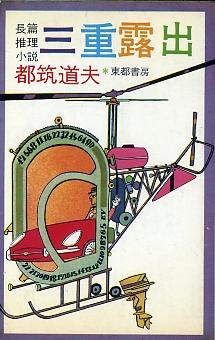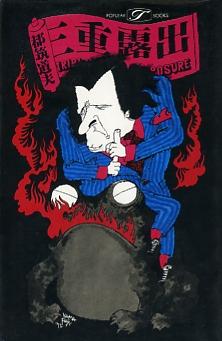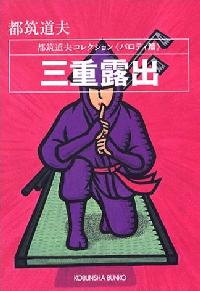Triple Exposure
S. B. Cranston in Japan
By William Wetherall
First drafted late 1970s
First posted 18 September 2006
Last updated 18 September 2006
The origin of Quillion SleighThe editor of Hayakawa Shobo's Ellery Queen's Mystery Magazine, from its start in 1956 through 1959, was Tsuzuki Michio, a Tokyo-born high-school dropout, turned journalist, turned editor, turned translator, turned writer in approximately this order. While editing for Hayakawa, Tsuzuki began translating Evan Hunter's Curt Cannon stories for the Japanese edition of Manhunt. Tsuzuki tells the story as follows (Tsuzuki 1975: 248-249).
The full-length detective story Tsuzuki was completing in 1972 was probably not Kirion Surei no seikatsu to suiri [The life and speculations of Quillion Sleigh], for this was first issued in February that year. Masaaki Kishi, in "Images of Americans in Japanese Popular Culture" (Journal of Popular Culture, 1975), stated that this was "the first Japanese detective story to have an American as its hero" -- but we know from Tsuzuki's account of his ghosting of Canno stories that this is not true. Even if one does not wish to count the ghosted Cannon stories as original Japanese fiction, one cannot ignore the interesting American protagonist that Tsuzuki created in 1964, between Cannon and Sleigh, in his seminal work, Sanju roshutsu [Triple exposure]. The novel takes the form of a translation of a story by an American [Amerikajin] named Cranston [Kuransuton]. The "translator" relates himself to the story after the opening chapters have unfolded. The "translated" chapters introduce a story of espionage and adventure set in Japan. The protagonist is an American [Amerikan] who is asked by a certain woman to do some sleuthing. The name of the woman turns out to be thtat of an actual person known to the "translator" and his friends, a woman who two years previously had been murdered with the criminal still at large and unidentified. The "translator" is motivated to analyze the non-Japanese story as a means of solving the real mystery. The "translated" chapters are contrived to view Japan through the eyes of a foreigner [gaijin]. By the time Tsuzuki brings himself to write this story, he is a practiced expert on American pulp fiction. He has both translated widely and published essays on numerous American, European, and Japanese writers of myster and fantasy fiction (collected, for example, in Tsuzuki 1973). Tsuzuki, at the time of this writing (late 1970s), was active as a member of the board of the Japanese Mystery Writers' Association [Nihon Suiri Sakka Kyokai] and continues to publish short stories in the less widely circulated monthly readers, while writing serialized and first-apppearance novels. Tsuzuki is not, however, a major writer of the mystery genre in Japan. There are probably a hundred contemporary writers in all forms of fiction in Japan -- popular, vernacular, and serious -- whose names are more familiar to the reading public. Tsuzuki's books are not best sellers in any sense of the word. Most of his novels seldom warrant more than one printing and are not easily found even hot off the press -- in sharp contrast with a score or two of other writers of "popular" detective and science fiction. Some of Tsuzuki's more popular titles, however, have been periodically re-issued over the decades. In addition to writers of "popular" fiction like Tsuzuki, there is a large class of "vernacular" fiction writers of mysteries who outproduce and outcirculate writers of the pulpier "popular" strain of the genre. Even some writers of "serious" fiction who dabble in mystery fiction outcirculate most "popular" writers, and they also tend to outdistance the "vernacular" writers in terms of their longevity after death. Fake translation rights pageMost books published in Japan -- even many that are published in English -- have the copyright information on a colophon at the back of the book. Many translations into Japanese, however, also have information relating to the translation rights in the front of the book, usually behind the title pagae. Sanju roshutsu has what, on quick inspection, would appear to be an actual statement of the translation rights arrangment -- except that the information (1) relates to the author, novel, and translator who appear in Tsuzuki's novel, and (2) is clearly a parody on the name of COPYRIGHT PAGE ON BACK OF SECOND TITLE PAGE
To be continued. |



